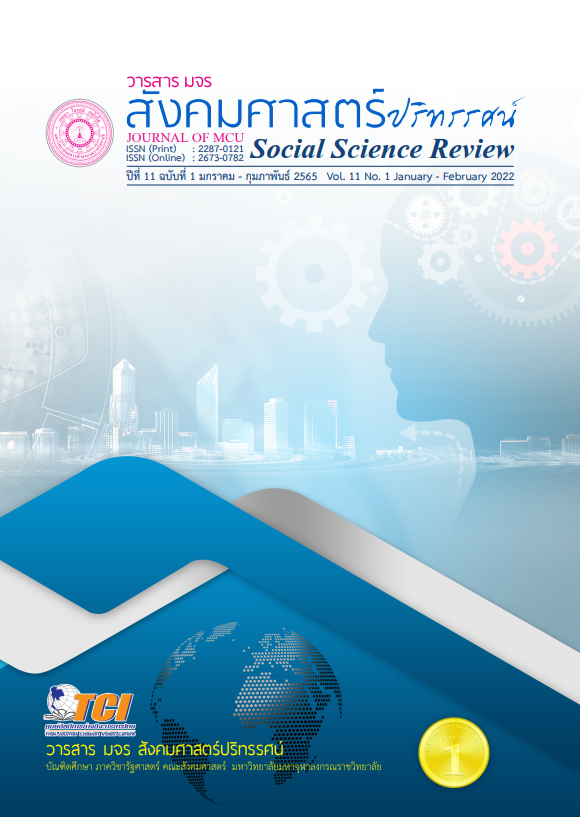หนังสือแจกงานศพกับความแปรเปลี่ยนของอารมณ์ความรู้สึกและความใฝ่ฝัน ของคนภาคใต้ ประเทศไทย ทศวรรษ 2460 – 2550
คำสำคัญ:
หนังสือแจกงานศพ, ประวัติศาสตร์อารมณ์ความรู้สึก, ประวัติศาสตร์ท้องถิ่นบทคัดย่อ
บทความวิจัยฉบับนี้ มีวัตถุประสงค์เพื่อศึกษาวิเคราะห์หนังสือแจกงานศพของภาคใต้ ทศวรรษ 2460 ถึงทศวรรษ 2550 โดยเป็นการวิจัยเขิงคุณภาพศึกษาตามแนวพินิจทางประวัติศาสตร์ (Historical approach)
ผลการวิจัยพบว่า หนังสือแจกงานศพของสังคมท้องถิ่นใต้ ทศวรรษ 2460 - 2550 เป็นการนำเสนอข้อมูลชีวประวัติบุคคลของผู้เสียชีวิตหรือไม่ใช่แค่เป็นเพียงหลักฐานทางประวัติศาสตร์ที่แสดงข้อสนเทศเท่านั้น หากแต่มีความสำคัญในแง่ที่เป็นพื้นที่ของความคิด อารมณ์ความรู้สึกและความใฝ่ฝันซึ่งสัมพันธ์กับบริบทแวดล้อมทางสังคม เศรษฐกิจ การเมือง และระบบวัฒนธรรม ฉะนั้น หนังสือแจกงานศพของสังคมภาคใต้จึงเผยให้เห็นความแปรเปลี่ยนของอารมณ์ความรู้สึกและความใฝ่ฝันของคนภาคใต้ ออกได้เป็น 4 ระยะ กล่าวคือ ระยะแรก ช่วงแรก ทศวรรษ 2460 ถึงต้นทศวรรษ 2490 ช่วงแรกเป็น “กลไกของระบบราชการสมัยใหม่” มีผลซึมลึกเข้าไปสู่ระบบคุณค่าและความหมายของชีวิตผู้คนในสังคมท้องถิ่นให้อยู่เริ่มเชื่อมโยงตัวตนกับรัฐไทยสมัยใหม่ที่ก่อกำเนิดขึ้น ระยะต่อมา กลางทศวรรษ 2490 – 2510 เป็นยุคแห่งการสร้าง “แบบแผน” ความภาคภูมิใจต่อความสำเร็จของบุคคลในการสร้างฐานะทางเศรษฐกิจและหน้าที่การงาน ระยะที่ 3 ทศวรรษ 2520 – 2530 การนำเสนอเส้นทางเดินชีวิตเน้นให้เห็นพื้นเพความเป็น “คนบ้านนอก-ชนบท” แต่สามารถเข้าสู่ระบบราชการและระบบการผลิตสมัยใหม่จนประสบความสำเร็จ และช่วงปัจจุบัน นับตั้งแต่ทศวรรษ 2540 เป็นต้นมา หนังสือแจกงานศพไม่ได้เป็นเพียงพื้นที่ความหมายของคนตายเท่านั้น แต่ได้กลายเป็นพื้นที่ของการแสดงออกเกียรติ ศักดิ์ศรี และการจัดวางตำแหน่งแห่งที่ของ “คนเป็น”ด้วย
เอกสารอ้างอิง
Dutton, L. S. (1999). Anthropological Resources: A Guide to Archival Library, and Museum Collections. New York: Garland.
Kosaikanon, P. D. (1933). Country, Nation, Religion, King. Printed for Distribution at the Funeral of the Preceptor (Dang) at Huai Luek Temple, Huai Luek Subdistrict, Pak Phayun District. Phra Nakhon: Phrachan Printing Factory.
Nuchpiam, T. (2009). “Who Does History Serve?” in History in the Dimension of Educational Culture: Collection of Articles from the 7th Annual Anthropological Conference, Overhaul on Cultural Studies. Bangkok: Sirithorn Anthropology Center. (In Thai)
Phra Dhammavarodom. (1931). Persuading Monks to Work Hard to Establish a Thai Book School in the Temple of Phra Dhammawarodom Primate of Nakhon Si Thammarat and Phuket Provinces. Songkhla: Panich Printing House. (In Thai)
Phra Samuh Dang. (1936). History of Phrakhru Hemchetiyanurak: Printed for Distribution in the Royal Cremation Ceremony at Tha Mon Temple, 1 June 1936. Nakhon Si Thammarat: Mitbamrung Printing Factory. (In Thai)
Prince Damrong Rajanubhab, H. R. H. (1917). “Introduction”In the Cremation Book of Jao Jom Im, Mueang Nakhon Si Thammarat, 1917. Phra Nakhon: Sophonpipattanakorn Printing. (In Thai).
Prince Phramahasamanachao Kromphraya Vajirananavarorasa, H. R. H. (1924). Nangsue Atta Saat: Printed as Cremation Book of Phrakruvijarnseelkhun (Chou), Amphoe Ja Ting Pra, Changwat Songkhla, 1924. Phra Nakhon: Nukoonvattana Printing. (in Thai).
Raynolds, C. J. (2007). “The Case of K.S.R. Kulap: A Challenge to Royal Historical Writing in Late Nineteenth Century Thailand” In Chao Sua, Khun Suk, Sakdina, Panyachon, Khonsaman. Bangkok: The Foundation for the Promotion of Social Sciences and Humanities Textbooks Project. (In Thai)
Sattayanurak, A. (2013). “Identities Meaning: Evolution of Cremation Books” In History, Religion, Culture and Education: Thai Studies Collection Printed in Remembrance of Ishii Yoneo. BangkoK: SangSan. (In Thai)
Saengthong, P. (2020). Local Literature and the Rehabilitation of Social Power in Communities in the Songkhla Lake District. Bangkok: OSMEP. (In Thai)
Yoneo, I. (1989). “Admiring Words” In Catalog of Thai Cremation Volumes in the Charas Collection, the Center for Southeast Asian Studies Library Kyoto University. Marasri Sivaraksa (Edit). Kyoto: the Center for Southeast Asian Studies Kyoto University.
________. (2007). “Reung Khong NangSueJaek” In Kueng Satawat Thai SuKsa (Michi wa hirakeru-Tai kenkyu no goju nen) (Chawalin Sawettanan, Kanokwan Ketu Chaimat, Tran.) Bangkok: Toyota Foundation.
ดาวน์โหลด
เผยแพร่แล้ว
รูปแบบการอ้างอิง
ฉบับ
ประเภทบทความ
สัญญาอนุญาต
ลิขสิทธิ์ (c) 2022 วารสาร มจร สังคมศาสตร์ปริทรรศน์

อนุญาตภายใต้เงื่อนไข Creative Commons Attribution-NonCommercial-NoDerivatives 4.0 International License.
เพื่อให้เป็นไปตามกฎหมายลิขสิทธิ์ ผู้นิพนธ์ทุกท่านต้องลงลายมือชื่อในแบบฟอร์มใบมอบลิขสิทธิ์บทความให้แก่วารสารฯ พร้อมกับบทความต้นฉบับที่ได้แก้ไขครั้งสุดท้าย นอกจากนี้ ผู้นิพนธ์ทุกท่านต้องยืนยันว่าบทความต้นฉบับที่ส่งมาตีพิมพ์นั้น ได้ส่งมาตีพิมพ์เฉพาะในวารสาร มจร สังคมศาสตร์ปริทรรศน์ เพียงแห่งเดียวเท่านั้น หากมีการใช้ภาพหรือตารางหรือเนื้อหาอื่นๆ ของผู้นิพนธ์อื่นที่ปรากฏในสิ่งตีพิมพ์อื่นมาแล้ว ผู้นิพนธ์ต้องขออนุญาตเจ้าของลิขสิทธิ์ก่อน พร้อมทั้งแสดงหนังสือที่ได้รับการยินยอมต่อบรรณาธิการ ก่อนที่บทความจะได้รับการตีพิมพ์ หากไม่เป็นไปตามข้อกำหนดเบื้องต้น ทางวารสารจะถอดบทความของท่านออกโดยไม่มีข้อยกเว้นใดๆ ทั้งสิ้น





